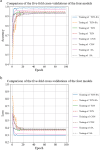Automatic detection of epilepsy from EEGs using a temporal convolutional network with a self-attention layer
- PMID: 38824547
- PMCID: PMC11143608
- DOI: 10.1186/s12938-024-01244-w
Automatic detection of epilepsy from EEGs using a temporal convolutional network with a self-attention layer
Abstract
Background: Over 60% of epilepsy patients globally are children, whose early diagnosis and treatment are critical for their development and can substantially reduce the disease's burden on both families and society. Numerous algorithms for automated epilepsy detection from EEGs have been proposed. Yet, the occurrence of epileptic seizures during an EEG exam cannot always be guaranteed in clinical practice. Models that exclusively use seizure EEGs for detection risk artificially enhanced performance metrics. Therefore, there is a pressing need for a universally applicable model that can perform automatic epilepsy detection in a variety of complex real-world scenarios.
Method: To address this problem, we have devised a novel technique employing a temporal convolutional neural network with self-attention (TCN-SA). Our model comprises two primary components: a TCN for extracting time-variant features from EEG signals, followed by a self-attention (SA) layer that assigns importance to these features. By focusing on key features, our model achieves heightened classification accuracy for epilepsy detection.
Results: The efficacy of our model was validated on a pediatric epilepsy dataset we collected and on the Bonn dataset, attaining accuracies of 95.50% on our dataset, and 97.37% (A v. E), and 93.50% (B vs E), respectively. When compared with other deep learning architectures (temporal convolutional neural network, self-attention network, and standardized convolutional neural network) using the same datasets, our TCN-SA model demonstrated superior performance in the automated detection of epilepsy.
Conclusion: The proven effectiveness of the TCN-SA approach substantiates its potential as a valuable tool for the automated detection of epilepsy, offering significant benefits in diverse and complex real-world clinical settings.
Keywords: Attention mechanism; Convolutional neural network; EEG; Epileptic seizure; Pediatric epilepsy.
© 2024. The Author(s).
Conflict of interest statement
The authors declare that they have no known competing financial interests or personal relationships that could have appeared to influence the work reported in this paper.
Figures
















Similar articles
-
A review of epilepsy detection and prediction methods based on EEG signal processing and deep learning.Front Neurosci. 2024 Nov 15;18:1468967. doi: 10.3389/fnins.2024.1468967. eCollection 2024. Front Neurosci. 2024. PMID: 39618710 Free PMC article. Review.
-
Epileptic Seizure Prediction Using Spatiotemporal Feature Fusion on EEG.Int J Neural Syst. 2024 Aug;34(8):2450041. doi: 10.1142/S0129065724500412. Epub 2024 May 22. Int J Neural Syst. 2024. PMID: 38770650
-
An automated detection of epileptic seizures EEG using CNN classifier based on feature fusion with high accuracy.BMC Med Inform Decis Mak. 2023 May 22;23(1):96. doi: 10.1186/s12911-023-02180-w. BMC Med Inform Decis Mak. 2023. PMID: 37217878 Free PMC article.
-
Automatic detection of epileptic seizure based on approximate entropy, recurrence quantification analysis and convolutional neural networks.Artif Intell Med. 2020 Jan;102:101711. doi: 10.1016/j.artmed.2019.101711. Epub 2019 Sep 7. Artif Intell Med. 2020. PMID: 31980085
-
Review on Epileptic Seizure Prediction: Machine Learning and Deep Learning Approaches.Comput Math Methods Med. 2022 Jan 20;2022:7751263. doi: 10.1155/2022/7751263. eCollection 2022. Comput Math Methods Med. 2022. Retraction in: Comput Math Methods Med. 2023 Dec 13;2023:9853636. doi: 10.1155/2023/9853636. PMID: 35096136 Free PMC article. Retracted. Review.
Cited by
-
A hybrid CNN-Bi-LSTM model with feature fusion for accurate epilepsy seizure detection.BMC Med Inform Decis Mak. 2025 Jan 6;25(1):6. doi: 10.1186/s12911-024-02845-0. BMC Med Inform Decis Mak. 2025. PMID: 39762881 Free PMC article.
-
Linear regressive weighted Gaussian kernel liquid neural network for brain tumor disease prediction using time series data.Sci Rep. 2025 Feb 18;15(1):5912. doi: 10.1038/s41598-025-89249-w. Sci Rep. 2025. PMID: 39966518 Free PMC article.
-
A review of epilepsy detection and prediction methods based on EEG signal processing and deep learning.Front Neurosci. 2024 Nov 15;18:1468967. doi: 10.3389/fnins.2024.1468967. eCollection 2024. Front Neurosci. 2024. PMID: 39618710 Free PMC article. Review.
-
MRI based early Temporal Lobe Epilepsy detection using DGWO based optimized HAETN and Fuzzy-AAL Segmentation Framework (FASF).PLoS One. 2025 Jul 2;20(7):e0325126. doi: 10.1371/journal.pone.0325126. eCollection 2025. PLoS One. 2025. PMID: 40601647 Free PMC article.
References
MeSH terms
Grants and funding
LinkOut - more resources
Full Text Sources
Medical

